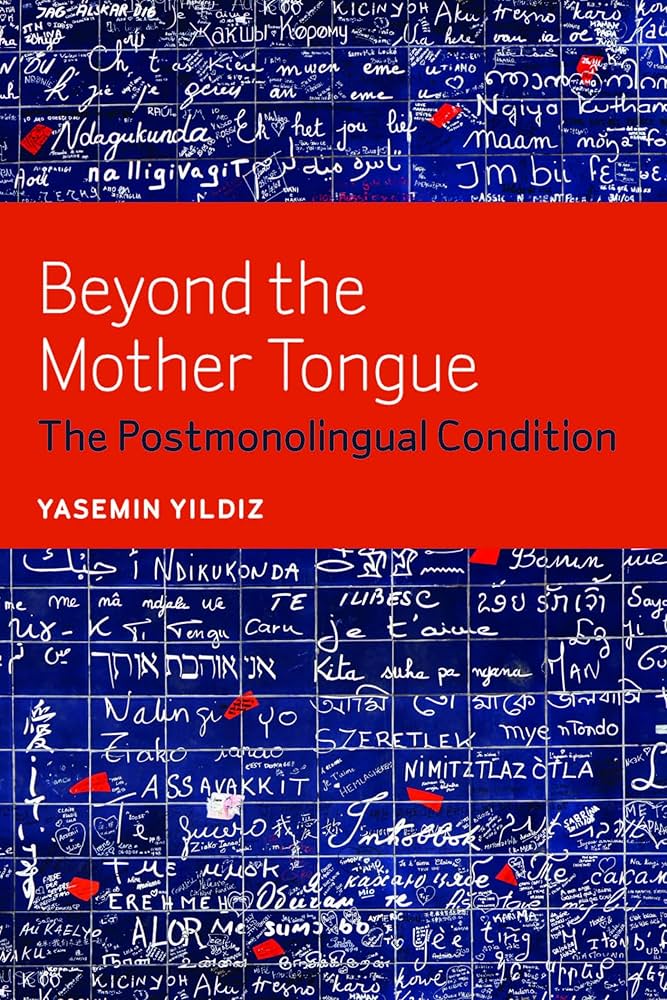Beyond the Mother Tongue: The Postmonolingual Condition
by Yasemin Yildiz
Reviewed by Christina Butler
Yasemin Yildiz, Beyond the Mother Tongue: The Postmonolingual Condition. New York: Fordham University Press, 2011. Cloth, $55.00.

Yasemin Yildiz has provided a much-needed new look into the recent discourse on multilingualism and monolingualism. Rather than perpetuating a multilingual-monolingual dichotomy, Yildiz presents a new framework, in which co-existing multilingualisms and monolingualisms are defined by their interaction and tension with each other; she regards this interaction and its developments as “the postmonolingual condition.” In this framework, Yildiz argues that multilingualism has always been a historical constant, but its meaning has changed as a result of the modern monolingual lens of the Western nation-state narrative and the construction of the individual’s role within it. In her analyses, Yildiz discusses how literary texts, themselves, perform a particular relationship between unitary languages and civic inclusion within a national collective. Yildiz claims, however, that this dominant monolingual paradigm has been implemented unevenly in various geopolitical contexts, such as in immigrant communities and border zones, and therefore, cannot be used as the only defining principle of language development and use. Accordingly, she introduces the “postmonolingual” paradigm, which “can bring into sharper focus the back-and-forth movement between these two tendencies that characterizes contemporary linguistic constellations” (5). Yildiz’s concept of the postmonolingual condition as the co-existence of the monolingual nation-state paradigm alongside multilingual formations offers an alternative analysis of how societies construct and interweave linguistic subjectivity with national community. Yildiz outlines the postmonolingual paradigm in five chapters through the works of Franz Kafka, Theodor W. Adorno, Yoko Tawada, Emine Sevgi Özdamar, and Feridun Zaimoglu.
Chapter One is a close examination of monolingualism and Jewishness as seen in Franz Kafka’s journals and letters in late imperial Prague. Although Prague was the setting for multiple coexisting languages, Yildiz points out that one’s identification and legitimacy within a language community was conditioned by the growing German and Czech nationalist movements. This monolingualizing process, as she describes it, was especially tenuous for German- or Czech-speaking Jewish communities because of their non-acceptance by the dominant German and Czech language communities. Yildiz outlines how literary members of the urban Jewish communities dwelled on the uncanniness of the German language because, as assimilated Jews, they were not considered able to appropriate and master German as native speakers. This tension and one’s ability “to work though” (35) language and ethno-cultural identity is what Yildiz considers as the essence of Kakfaesque writing—especially through figural inflection in German, Yiddish, “Jargon,” and French. Yildiz claims that although Kafka at first tried to operate within the monolingual paradigm, wedding language and identity, it was his working through the imaginary power of this paradigm and its “radical depropriation” (65) in the postmonolingual condition that dismantled the idea that one’s identity is not based on a language given through national origin and natural property.
Chapter Two analyzes Theodor W. Adorno’s epistemological conception of loanwords in “Über den Gebrauch von Fremdwörtern” (1958) and “Wörter aus der Fremde” (1959) as well as in his language memoir Minima Moralia (1951). Yildiz maintains that Adorno shows another aspect of the postmonolingual condition in which the monolingual conception of contextuality is rejected. Instead, she sees Adorno’s work and use of Fremdwörter as “sites of nonidentity that testify to the resistance of the particular to the universal” (70). In the nationally conceived monolingual paradigm, internal multilingualism is considered a threat to a language’s purity and resilience. Fremdwörter are unassimilated words that are alienated from the native language because they stand out from other words in a text due to italicization or not being translated. Yildiz calls attention to how Adorno rejects this idea of “mother-tongue” alienation, but instead shows how loanwords are themselves touchstones of a nation’s inner anxiety within the interactions between mono- and multilingualism.
In her third chapter, Yildiz traces the manner in which the concepts of liberation and social visibility found in Yoko Tawada’s Till (1998), Talisman (1996) and Überseezungen (2002) engage with the postmonolingual condition. Yildiz sees Tawada’s characters as seeking the bilingual experience through territorial and linguistic movement, but it is through this performance of multilingualism that an individual’s monolingual history is highlighted. Yildiz argues that Tawada’s characters willingly learn the multiple languages of their host countries in order to reinvent themselves from the stigmas of their prescribed “mother-tongue” because it questions the construct of the “mother-tongue” from within. Subjective multiplicity and multilingualism invisibly construct how one sees the world. Yildiz claims that this is a critique of the monolingual paradigm as it weakens its superficially enforced structures of inclusion. The tension between co-existing multilingualism and monolingualism in postmonolingualism questions the concepts of language and identity, and causes the subject to examine his or her place in a global context.
Chapter Four examines Emine Sevgi Özdamar’s use of language and literal translation in Mutterzunge (1990) as a process of working through trauma on her “mother-tongue.” Unlike Adorno, who finds pleasure in code-switching, Özdamar’s text reflects on the feeling of losing a familial “mother-tongue” due to a long history of state-enforced language change and political activism in Turkey, to migration from Turkey to Germany, and to a female protagonist’s space among family with different temporal and spatial connections to all these phenomena. Yildiz examines Özdamer’s Turkish proverbs and grammatical structures, translated directly into the German language, and how their reception as literal translation recodes audiences’ “mother-tongue.” Yildiz considers this an act of postmonolingualism, where Turkish-German writers confront an assumed monolingual “mother-tongue” through an estrangement of that language in direct translation into another language. Through this estrangement, writers can retell their loss and trauma in a new perspective created by the new language. This act, as Yildiz points out, represents Özdamar’s survival of the violent and oppressive “mother-tongue” in a monolingual paradigm by her ability to move beyond its limitations through multilingualism and multiple perspectives.
In the final chapter, Yildiz reveals the disjuncture of language and ethnicity in the monolingual paradigm among Turkish immigrants’ children through the work of Feridun Zaimoglu’s Kanak Sprak (1995). Yildiz characterizes the parallelism between multilingualism and monolingualism in the postmonolingual condition in second- and third-generation Turkish-German immigrants who do not speak the language of the assumed ethnic “mother-tongue.” The importance of Zaimoglu’s Kanak Sprak monologues for Yildiz is that the linguistic form each man takes in describing his life situation is actually not found on the streets of Germany, but is an invented vernacular, mixing German terms, Turkish expressions, African-American hip hop forms, and Yiddish terms, among this male-gendered group. Yildiz finds Zaimoglu’s avant-garde linguistic approach to be an intervention between cultural boundaries through linguistic originality. She sees his monologues as a productive site of identity formation while questioning the monolingual notion that one naturally has access to a language due to birth and cultural heritage. Yildiz analyzes this tension between multilingual production and usage in a male speech community, and the restrictive monolingual ethnic stigmas put on them, as a defiant appropriation of language by the postmigrant subject in a postmonolingual Germany. It is in this site that Yildiz sees male figures going beyond national and linguistic borders prescribed by the monolingual paradigm and constructing a creative mix of languages to show the ever-changing linguistic and cultural identities of postmigrant communities.
Yasemin Yildiz has written an award-winning monograph that deconstructs the conceptual frameworks of multilingualism and monolingualism that canonical and minority writers have been limited to. Through her study of the tensions within the postmonolingual condition, she brings into account different temporal and culturally spatial aspects of linguistic construction, which recasts assumed knowledge of social and cultural formation. Although further study of the phenomenon of Germany’s former and persistent “East-West” condition in her monograph would have yielded an even broader analysis, Yildiz has provided a hallmark exposition for the contemporary multilingual-monolingual-postmonolingual discussion growing ever more present in German Studies today. Her reconceptualization of the connection between language, culture, and literature paves the way for a new, holistic approach to German Studies, one that goes beyond eighteenth- and nineteenth-century German philosophies of linguistic nativism as defined by Herder, von Humboldt, and Schleiermacher, wherein the notion of the “mother-tongue” is the unifying element in the nation-state narrative. Yildiz rejects the homogeneity implicit in mother-tongue ideologies, demanding acknowledgment of the multilingual and heterogeneous realities found in German-speaking culture and literature.
—Christina Butler (University of Arizona)
